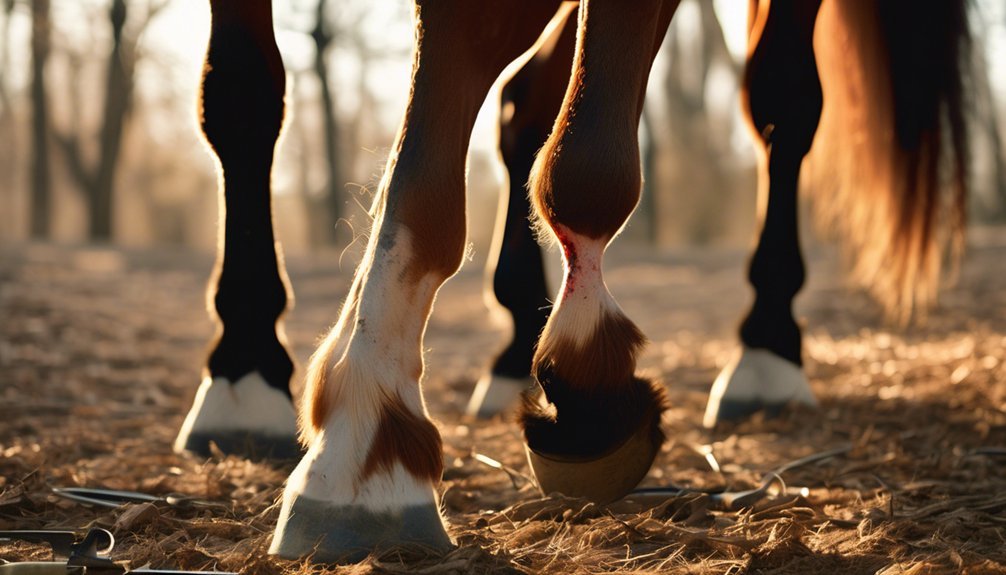
Identifying and treating skin conditions in horses requires keen observation and a systematic approach. You'll want to look for signs such as unusual texture, swelling, or persistent scratching. These symptoms can indicate underlying issues that need attention. Understanding the various conditions and their treatments is crucial. However, the path to effective management isn't always straightforward and can involve multiple steps. What you discover next could significantly impact your horse's well-being.
Key Takeaways
- Regularly inspect your horse's skin and coat for changes in texture, redness, or unusual bumps to identify potential skin issues early.
- Look for signs of irritation, such as excessive rubbing or scratching, which may indicate discomfort or underlying skin conditions.
- Consult a veterinarian for accurate diagnosis, utilizing visual examinations, skin scrapings, and understanding the characteristics of any lesions present.
- Treat identified skin conditions with appropriate topical treatments, dietary supplements, and antimicrobial washes to promote healing and skin health.
- Maintain a balanced diet and regular grooming routine to prevent skin issues and support overall equine skin health.
Common Horse Skin Conditions

When it comes to horse care, recognizing common skin conditions is crucial for maintaining your horse's health.
Horse allergies often manifest as hives or dermatitis, triggered by environmental factors, feed, or insect bites. These allergic reactions can lead to intense itching, making your horse uncomfortable.
Skin infections, on the other hand, may arise from bacteria or fungi, commonly presenting as sores or scabs. Conditions like rain rot are particularly prevalent in humid environments, requiring prompt attention.
Pay careful attention to your horse's coat and skin, as early identification of these issues can prevent more serious complications.
Recognizing Symptoms of Skin Issues
Although various skin issues can affect horses, recognizing their symptoms early can significantly impact treatment and recovery. You should maintain symptom awareness by observing your horse's skin closely.
Look for changes in texture, such as dryness, flakiness, or unusual bumps. Pay attention to any signs of irritation, like redness or swelling, and note if your horse is excessively rubbing or scratching. Discharge or abnormal odor can indicate infection.
Early detection is crucial, as many conditions worsen without prompt attention. Regular grooming and inspection can help you catch symptoms early, ensuring you can act swiftly.
Diagnosing Skin Conditions in Horses

How can you accurately diagnose skin conditions in your horse? Start by familiarizing yourself with skin condition terminology, as understanding the specific terms will aid in effective communication with your veterinarian.
Use diagnostic methods such as visual examinations, skin scrapings, and biopsies to gather essential information. Pay close attention to the characteristics of the lesions, including size, shape, and distribution. Note any underlying symptoms, such as itching or swelling, which can provide clues.
Additionally, consider environmental factors and recent changes in your horse's routine, as these can influence skin health. By methodically analyzing these elements, you can help your vet pinpoint the issue, leading to a more targeted approach for your horse's well-being.
Treatment Options for Common Skin Problems
Accurate diagnosis sets the stage for effective treatment of your horse's skin problems.
Upon identifying the issue, you can implement targeted solutions. Here are four key treatment options:
- Topical Treatments: Apply medicated creams or ointments to soothe irritation and promote healing.
- Dietary Supplements: Incorporate omega fatty acids or biotin to enhance skin health from within.
- Antimicrobial Washes: Use specialized shampoos to cleanse and eliminate bacteria or fungi.
- Regular Grooming: Maintain a routine grooming schedule to remove dirt and debris, preventing further skin issues.
Preventative Care for Horse Skin Health

To maintain optimal skin health in horses, you must adopt a comprehensive preventative care strategy that addresses environmental factors, nutrition, and grooming practices.
Start by evaluating dietary influences; a balanced diet rich in essential fatty acids, vitamins, and minerals supports healthy skin and coat. Regularly assess your horse's forage and grain to ensure they're receiving adequate nutrients.
Equally important are your grooming practices. Daily brushing helps remove dirt and debris while stimulating blood flow to the skin. Pay special attention to areas prone to irritations, such as under the mane and tail.
Additionally, regularly inspect your horse's skin for any changes. By combining proper nutrition with diligent grooming, you can significantly enhance your horse's skin health and overall well-being.
When to Consult a Veterinarian
While regular monitoring of your horse's skin can help catch minor issues early, there are specific signs that indicate it's time to consult a veterinarian.
Recognizing these signs is crucial for your horse's well-being. Here are four key indicators that require immediate attention:
- Persistent lesions or sores – If skin irritations don't heal within a few days.
- Swelling or heat – Noticeable inflammation or warmth in any area can signal infection.
- Severe itching or discomfort – Excessive scratching may indicate a deeper issue.
- Changes in behavior – Uncharacteristic agitation or reluctance to be touched might suggest pain.
Being proactive and identifying these signs requiring intervention can prevent more serious complications for your horse.
Home Remedies for Minor Skin Irritations

When your horse develops minor skin irritations, several effective home remedies can provide relief and promote healing. Natural remedies offer soothing treatments that can alleviate discomfort without harsh chemicals. Here's a quick reference table for some popular options:
| Remedy | Benefits | Application |
|---|---|---|
| Aloe Vera | Anti-inflammatory, cooling | Apply gel directly |
| Coconut Oil | Moisturizing, antibacterial | Massage into affected area |
| Oatmeal Bath | Soothing, itch relief | Soak for 15-20 minutes |
| Apple Cider Vinegar | Antiseptic, pH balancing | Dilute with water and spray |
| Calendula Cream | Healing, reduces irritation | Apply to the skin as needed |
Frequently Asked Questions
Can Horse Skin Conditions Affect Their Overall Health?
Yes, horse skin conditions can significantly impact their overall health. Skin infections compromise their immune response, making them more vulnerable to other illnesses and potentially leading to systemic issues if not addressed promptly and effectively.
Are Certain Breeds More Prone to Skin Issues?
Certain breeds indeed show susceptibility to skin issues due to genetic factors. You'll find that understanding these predispositions can help you better anticipate and manage potential skin conditions, ultimately promoting your horse's overall well-being and health.
How Do Weather Conditions Impact Horse Skin Health?
Weather extremes and humidity levels significantly affect your horse's skin health. High humidity promotes fungal growth, while cold, dry conditions can lead to dryness and irritation. You should monitor these factors closely to maintain your horse's skin integrity.
Can Nutrition Influence a Horse's Skin Condition?
Think of nutrition as the foundation of your horse's skin health; without proper dietary balance, deficiencies can lead to poor skin hydration. Ensuring a nutrient-rich diet promotes vibrant skin and a resilient coat, enhancing overall well-being.
What Are the Signs of an Allergic Reaction in Horses?
When observing horses, you'll notice signs of allergic reactions like itchy skin, swelling, and hives. These symptoms often indicate an underlying issue, so closely monitoring your horse's behavior and condition is crucial for effective management.
Conclusion
In conclusion, maintaining your horse's skin health is crucial, as studies show that nearly 30% of horses will experience some form of skin condition during their lifetime. By recognizing symptoms early and employing effective treatment options, you can significantly reduce the risk of complications. Regular grooming and a balanced diet play vital roles in prevention. Always be vigilant and proactive in your approach, as early intervention is key to ensuring your horse remains comfortable and healthy.





